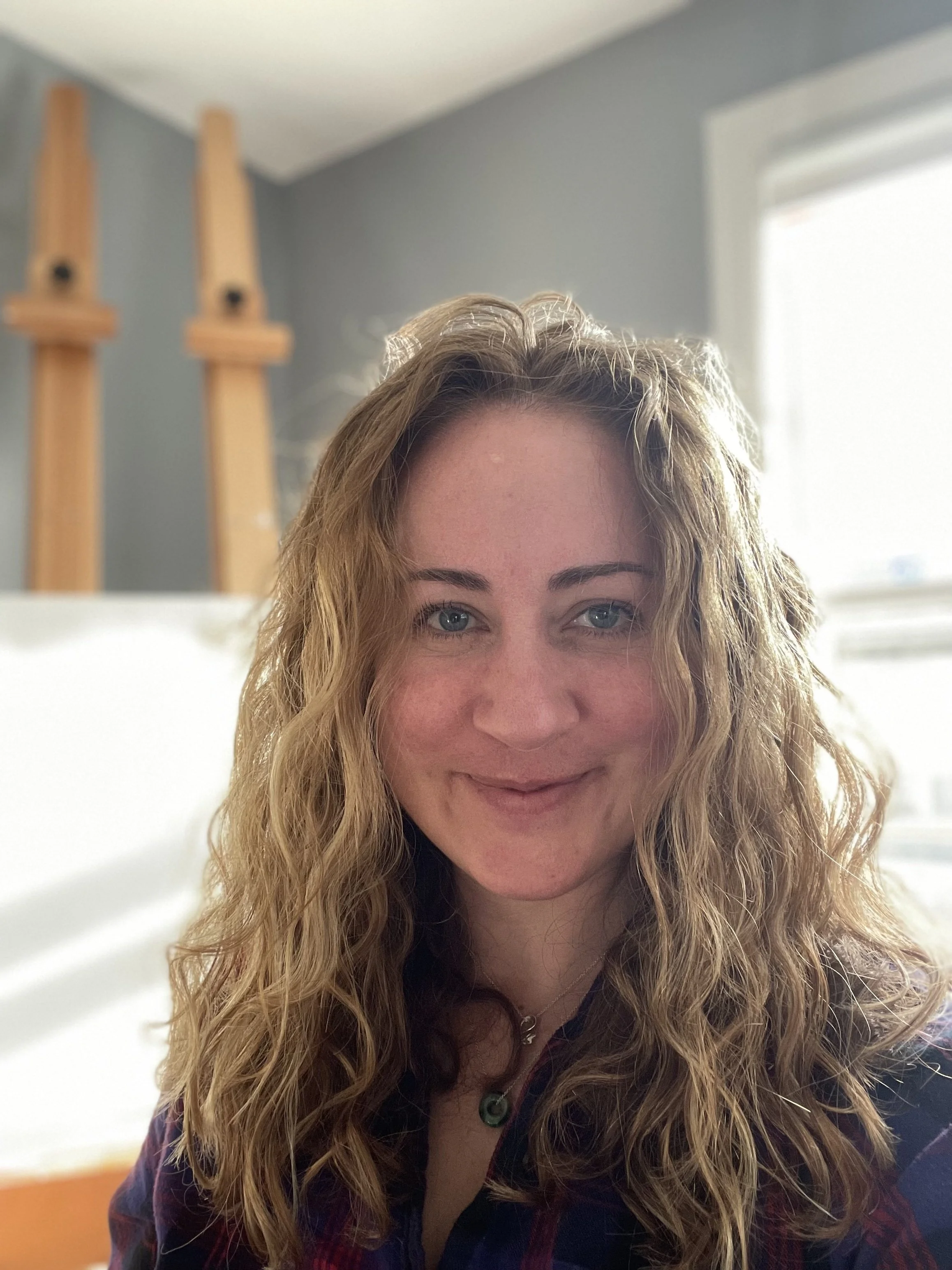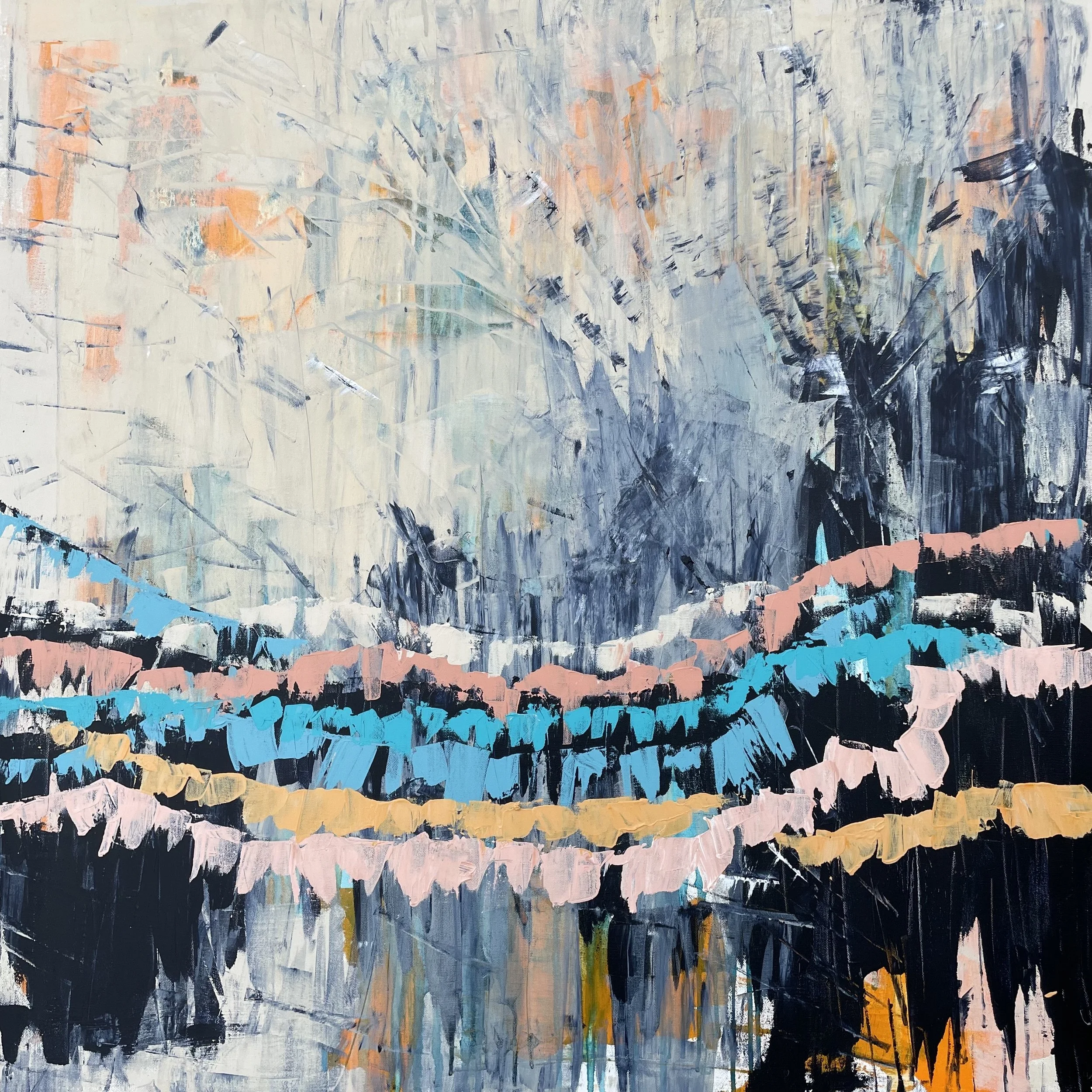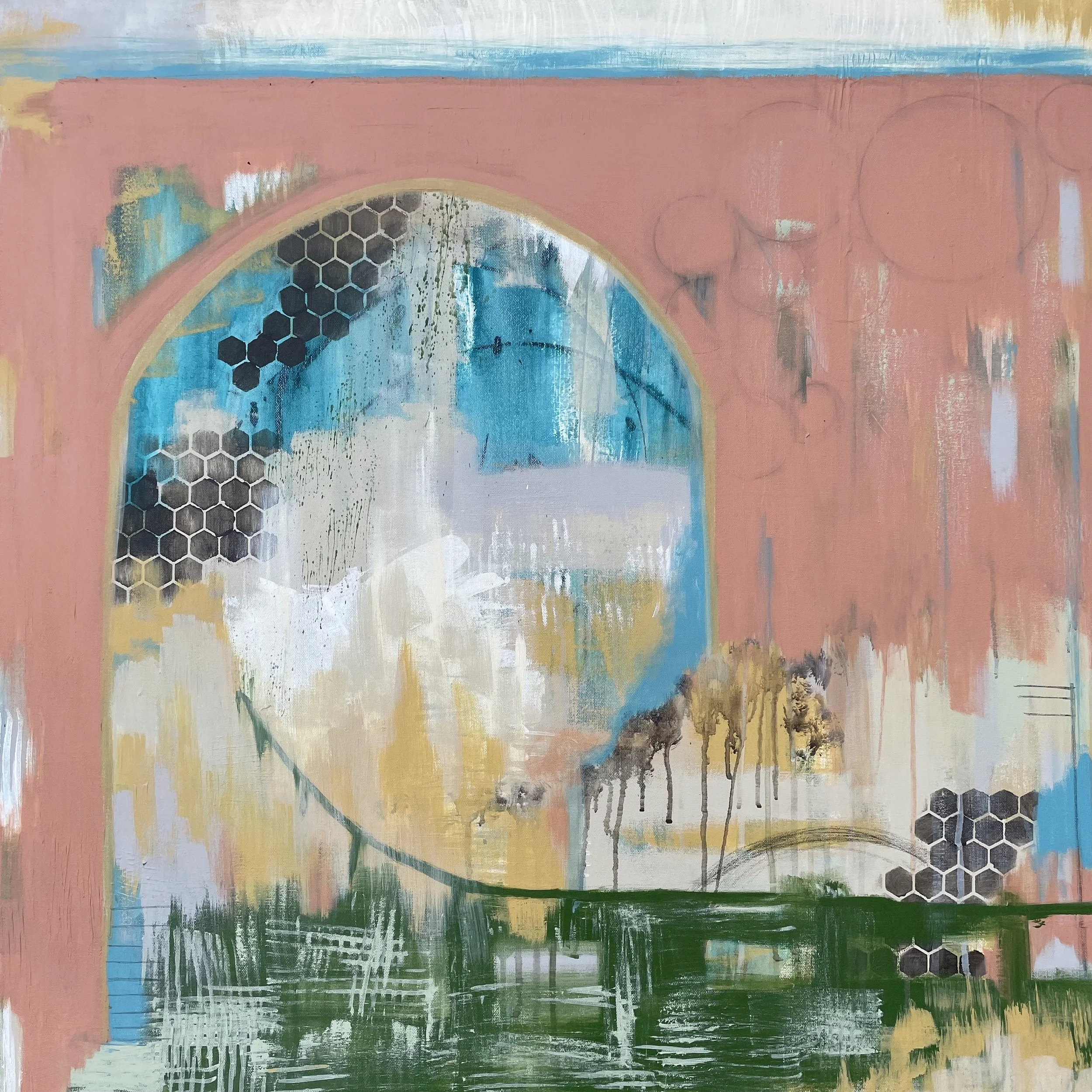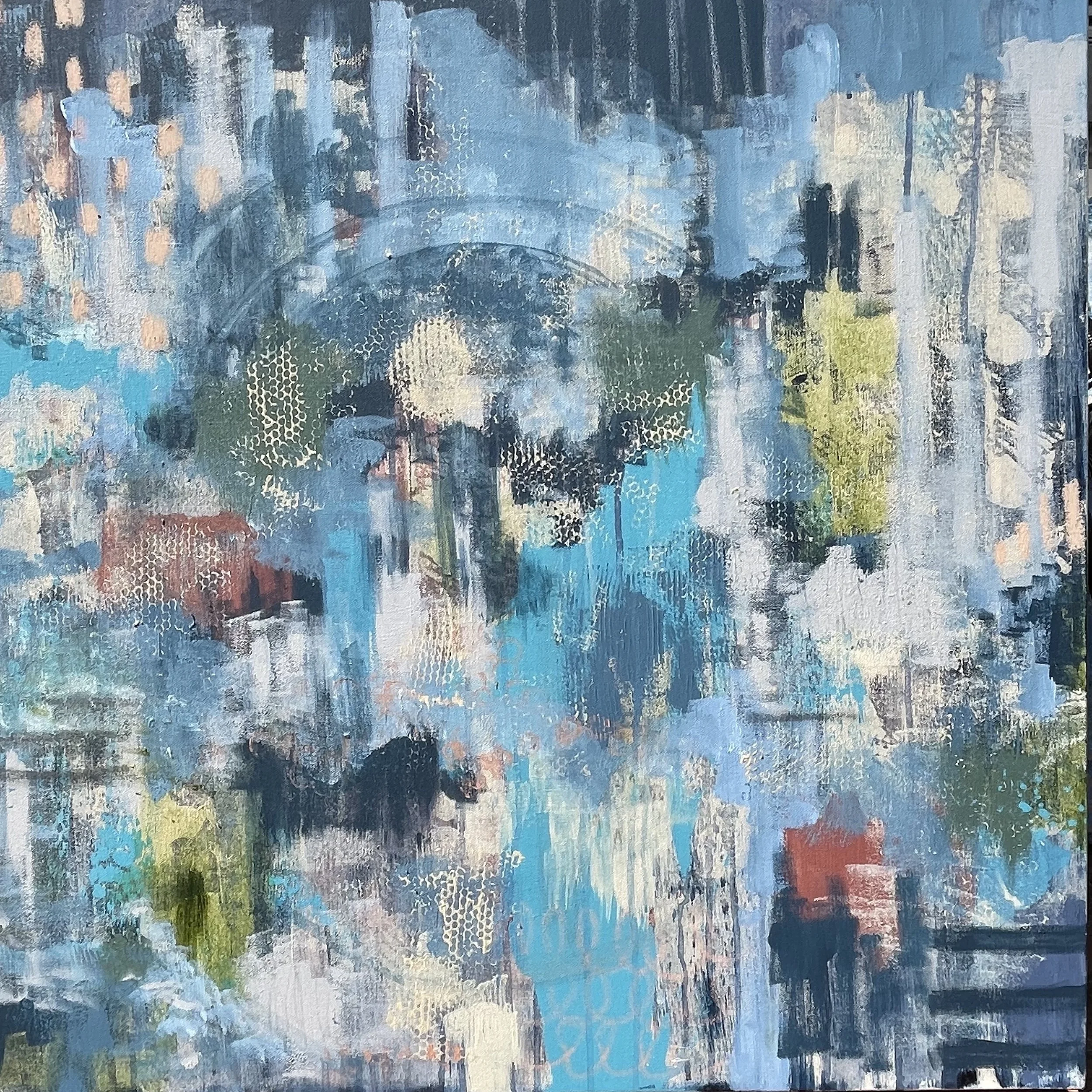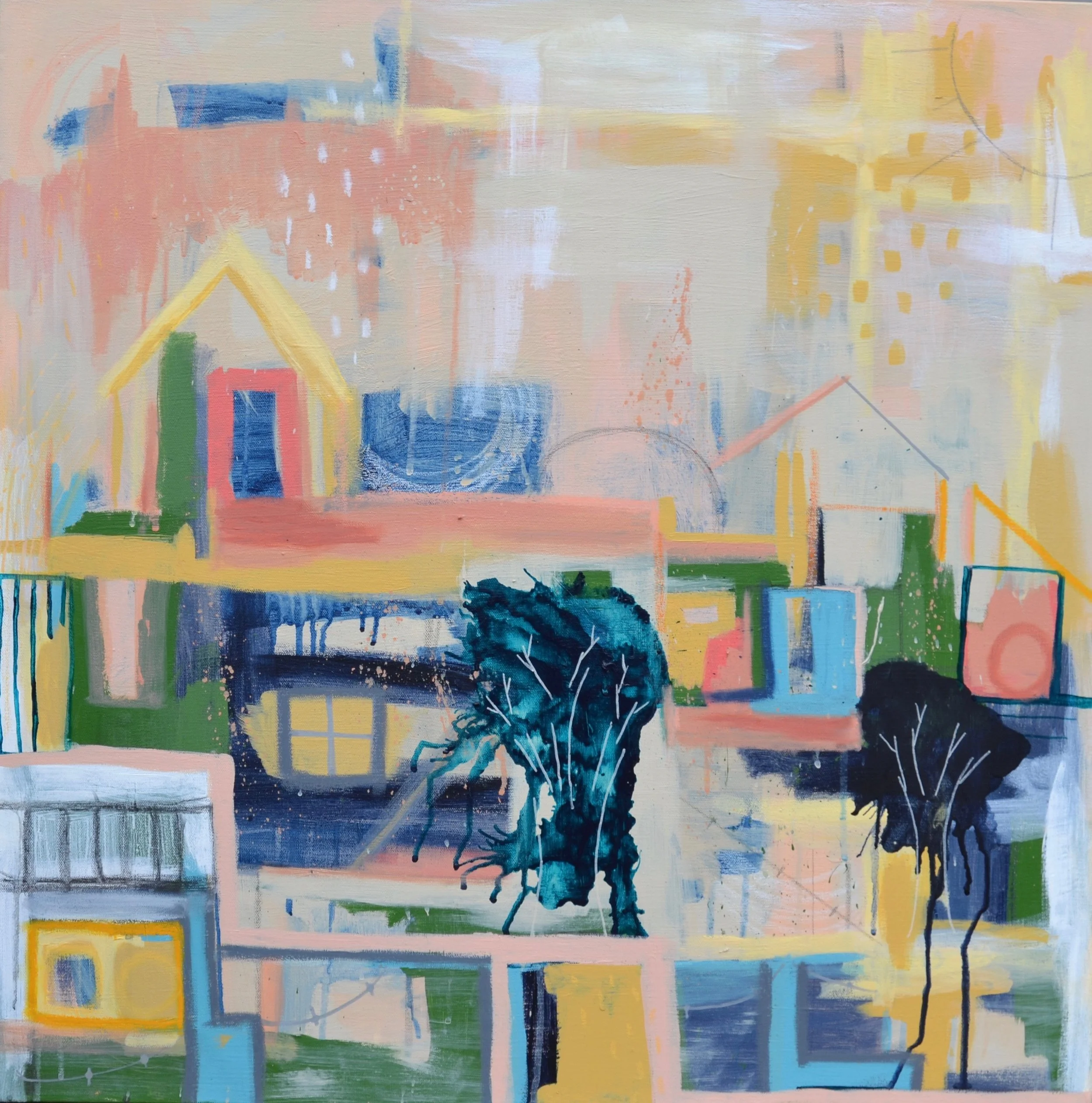Maureen Minard: Celebrating the Beauty of the Lesser-seen
Maureen Minard uses mixed media to document the shifting landscape of her everyday life. Utilizing acrylic paint, oil pastels, and graphite on canvas, Minard creates abstract compositions that capture the beauty in the world around her.
How did your creative journey begin?
As a child, I loved creating, drawing, painting, etching, woodblock, sewing, knitting, and weaving – really any material someone presented to me, I wanted to try. My grandmother, Serafina Nankervis, was an artist who focused on painting and sculpture. I would visit her studio and paint with her. A bit different from my classroom teachers, she really let me play and break rules, and she taught me to follow my own path. When I was ten, Serafina and my mother took me to the Georgia O’Keeffe retrospective at the National Gallery, and I felt like the paintings were windows into my daydreams. Up until her passing, my grandmother would visit and discuss our works in progress; no matter where I was in my journey, she took me seriously. I still paint on her easel with her favorite oil sticks in my home studio, and her sculptures that decorate my home remind me of her faith in me.
Where do you find inspiration for your work?
I paint overlooked, everyday spaces. We experience these landscapes so frequently that we often miss the details. I seek to document how our understanding of geography shifts over time. Instead of considering the most celebrated spaces near me, I paint a crumbling motel, the bridge I commute over, the construction cranes marking gentrification shifts, play structures in beloved parks, and neighborhoods where the legacy of segregation has been whitewashed. Being born and raised in the Washington DC region, a rare local Washingtonian, I feel the urgency to document the dramatic shifts and changes, while also celebrating the beauty, of the lesser-seen parts of the mid-Atlantic. Although my inspiration starts at a micro-local level, the themes in my art are universal, tapping into our shared experience of nostalgia for familiar geographies.
How has your work evolved over the last few years?
In college, I was an art history major and fell in love with studio classes. At Georgetown University, the art history department is housed with the fine art department, and we were encouraged to take many studio classes. I couldn't take enough. I loved learning the fundamentals of masterpieces, and the techniques and tools of modern artists. However, in the traditional classroom, I felt pressure to produce representational work, but it never felt like my authentic voice. When I had children, I took a break from oil painting and really focused on fiber arts and collage. These mediums allowed me to burst free from convention and break down basic shapes into new forms. When I began painting again five years ago, much older and wiser, I decided to venture into acrylics, mixed media and abstract painting. The materials gave me the ability to manipulate the composition into how I understand the world. I have also found abstract landscapes intriguing because artists can never reproduce reality. Often, we understand the feeling of a place more than we observe it. Through painting abstracted memories, I am hoping to connect with others on our emotional experience of space.
What does a typical day in the studio look like for you, and how has your art practice grown or changed?
Teaching full time and parenting tweens means my studio time is very, very precious. One of the lessons I learned from the pandemic is that I am much happier limiting social obligations and spending more time in the studio. In the evenings, I work a bit in my home studio collaging, watercoloring, or journaling, but the bulk of my painting happens during the weekends (or school breaks) in my studio outside the home. After making sure my hierarchy of needs are met with a long observational walk, a snack, and lots of coffee, I usually warm up with collaging, printing, or journaling. In my journal, I play with compositions, painting concepts, and plan color palettes. Music is a very important part of my art practice, as it helps me tap into nostalgia and memories. I listen to music of my adolescence and work on 2-3 canvases at a time, adding layers of expressionist forms. In the final layers, I sculpt a composition with a finer layer of paint and mark-making tools. In more recent years, I have moved away from relying on brushes, and instead use old objects and recycled materials as painting tools. I find these methods help me rethink how a memory landscape can be formed.
How does your work as a teacher impact your personal work as an artist?
In teaching, we celebrate that each person is always learning. Working with high school students, I learn from them about new ideas, approaches, and even myself. I urge them to take academic and creative risks, which reminds me to do the same. As an artist, one must be open to experimentation and the wisdom of other artists. I still love taking classes, working with other artists, and learning from the community at my studios. My students also teach me the joy of discovery. In my art history classes, the students do all of their work in journals. We talk about how this fine motor observational work helps them understand what they are looking at with greater detail. We take our journals to museums to learn in situ, documenting atmospheric perspective in a da Vinci in the National Gallery or creating a blind contour drawing in the Phillips Collection. We have done studio visits and met local artists, such as Lex Marie, an incredible up-and-coming contemporary artist who examines childhood and race in America. On our adventures, we discuss lesser known facts about the artists, share our discoveries from the journal entries, and we laugh so much about the history of art. Teens have a humorous way of pulling the world into perspective. Teaching has helped me maintain a sense of humor about my own art-making and refuel my passion for the power of art.
Which experiences have impacted your work as an artist?
Last year, the school community where I teach, and my daughter attends, was attacked by an active shooter. The experience has me reflecting on how we recover from traumatic events, and the role that place has in our recovery. A place we all loved and trusted suddenly was the center of our terror. Returning to the building and refilling it with love became a source of urgent need and anxiety. In order to return, we covered the school with art, encouraging posters, and signals of safety. As a teacher, colleague, and parent, I experienced the various perspectives one might feel recovering from such an experience. It was frustrating to listen to the national discourse on school shootings, as there is little support for how a community recovers and reclaims a sense of security. This experience really impacted my relationship with the public sphere and geographies of trauma. In well-meaning art work meant to address gun violence, artists often use imagery that can trigger post traumatic stress. Currently, I think very much about the role of an abstract landscape artist in re-imagining and reclaiming traumatic spaces in a language that doesn’t retraumatize the victims. In my recent show, I examined the legacy of segregation in my town, while also exploring how the town acknowledges the past and creates better landscapes for the future generations. The stories we tell about memories of place are complex, and inevitably political. My project as a contemporary artist is to complicate the field of abstract landscape with both the messy and the beautiful.
What are your future goals and aspirations?
In the past two years, I met several of my big goals: having a solo show, participating in a residency, and having a studio outside the home. Presently, I am in a cycle of creative play, where I am experimenting and contemplating my next steps. In the future, I would like to continue a series I worked on during my recent residency where I created several paintings addressing school shootings and reclaiming spaces of trauma. This series is much larger, and I hope to find a place to show the paintings and participate in a public discussion about the impact of gun violence. In the next ten years, my plan is moving to painting full-time and connecting even more to my local art community in the mid-Atlantic.
Instagram: @mominard_abstracts
Website: www.maureenminard.com

